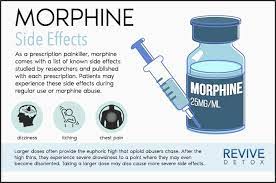Morphine is a powerful opioid medication primarily used for the management of severe pain. Here’s information about its uses, benefits, common symptoms, and potential side effects: Morphine Tablet Uses Benefits and Symptoms Side Effects

Uses and Benefits of Morphine:
- Pain Relief: Morphine is commonly used to relieve severe pain, such as that experienced after surgery, from injuries, or in certain medical conditions like cancer or terminal illnesses. It works by binding to opioid receptors in the brain and spinal cord, altering the perception of pain.
Common Symptoms and Side Effects of Morphine:
- Respiratory Depression: One of the most significant side effects of morphine is respiratory depression, where breathing becomes slow and shallow. It’s important to use morphine under medical supervision and closely monitor respiratory function.
- Sedation and Drowsiness: Morphine can cause sedation, drowsiness, and a feeling of relaxation. It can impair coordination and mental alertness, making it important to avoid activities that require full attention, such as driving or operating machinery.
- Constipation: Morphine commonly causes constipation due to its effects on the gastrointestinal system. It’s important to maintain proper hydration, follow a high-fiber diet, and consider taking stool softeners or laxatives to prevent or manage constipation.
- Nausea and Vomiting: Some individuals may experience nausea or vomiting as a side effect of morphine. Antiemetic medications may be prescribed to alleviate these symptoms.
- Itching and Skin Reactions: Morphine can cause itching or skin reactions in some individuals. Inform your healthcare provider if these symptoms are bothersome.
- Urinary Retention: Morphine can affect urinary function, leading to difficulty or inability to urinate. This effect may require medical intervention in some cases.
- Decreased Blood Pressure: Morphine can cause a drop in blood pressure (hypotension) in some individuals. This effect may be more pronounced when standing up, leading to dizziness or lightheadedness. Changes in posture should be done slowly.
- Dependency and Withdrawal: Prolonged use of morphine can lead to physical dependence and tolerance, requiring careful management and gradual discontinuation to prevent withdrawal symptoms.
It’s important to take
morphine as prescribed by your healthcare professional and follow their instructions regarding the dosage and frequency of administration. Morphine is a controlled substance with a high potential for abuse and addiction, so it should be used only under medical supervision.
Inform your healthcare
provider about any pre-existing medical conditions, medications, or substances you are taking to ensure the appropriate use of morphine. If you have any concerns or experience troubling side effects while taking morphine, consult with your healthcare provider for further evaluation and guidance.
Note:
Morphine should only be used under the supervision and guidance of a healthcare professional. It is not suitable for self-diagnosis or self-medication.
Morphine Tablet Uses Benefits and Symptoms Side Effects






